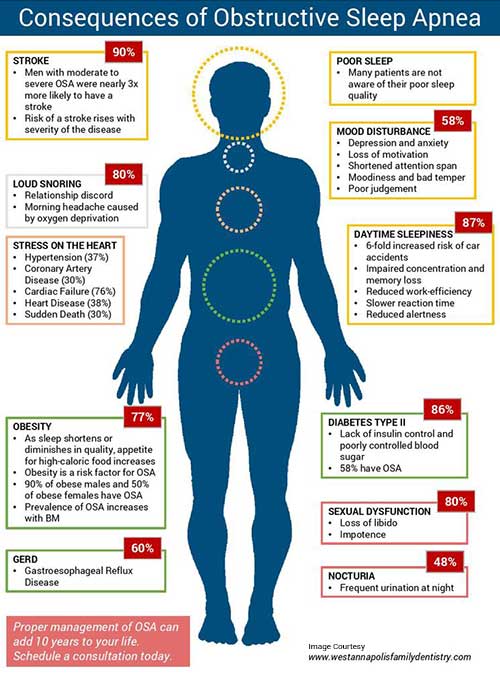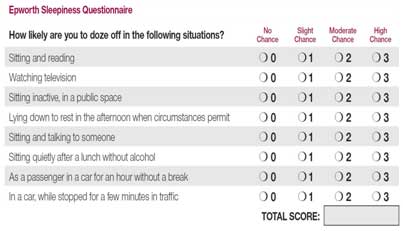Obstructive Sleep Apnea
Snoring is barely a problem that can be ignored; this is a sign of our body indicating an obstruction in the airway causing difficulty in breathing. Hence, pressing the snooze button on snoring is not a wise option. Snoring can affect our human body in various levels as shown below. OSA is a sleep-related breathing difficulty, occurring due to collapsing of the muscles and soft tissues in the upper airway thereby causing obstruction, cessation or a significant decrease in breathing, this in turn, causes hypoxia i.e., depletion of oxygen levels in the blood which inturn follows a cascade of ill effects.

Aetiology
Inspiration creates negative pressure within the pharynx; during wakefulness the muscle tone is maintained aiding to actively preserve upper airway patency but while asleep muscle tone declines. This causes an anatomical narrowing of the palatopharynx leading to inspiratory airway obstruction. Milder or incomplete obstruction leads to turbulence in airway flow causing snoring.A more severe obstruction triggers inspiratory efforts causing patients to wake up; these episodes are very brief and patients often have no recollection of these episodes.
Pathophysiologically, an obstruction may happen in various levels,for example – nasal obstruction, long, lax, thick soft palate, retrodisplaced mandible, narrow oropharynx, redundant pharyngeal tissues, large lingual tonsil, large tongue, large or floppy epiglottis or due to retro displaced hyoid complex.
Evaluation- TAKE A TEST
Quantitative Assessment – Epworth Sleepiness Scale
Dr John was the first to develop the Epworth sleepiness scale in 1990. This was further modified in 1997, the name was in honour of the Epworth Hospital in Melbourne where he established the Epworth sleep centre in 1988.

Scores
0-5: Lower normal daytime sleepiness
6-10: Higher normal daytime sleepiness
11-12: Mild excessive daytime sleepiness
13-15: Moderate excessive daytime sleepiness
16-24: Severe excessive daytime sleepiness
Any score above 11 would require an evaluation and further management.
Diagnostic Tests:
Polysomnography
This is also called sleep study, where the equipment that monitors brain, heart, lung movements, breathing patterns, limb movements and blood oxygen levels is attached while you are asleep. This can be done as a full night study. Polysomnography monitors your sleep in stages and cycles aiding in understanding your sleep patterns. The normal sleep cycle starts with NREM (non-rapid eye movement) sleep, brain waves are recorded by EEG(electroencephalogram). After stages 1,2,3 and 4 of the NREM sleep the brain activity picks up and the REM (rapid eye movement) stage of sleep begins, which is also the phase where dreaming is common. Normally multiple cycles of NREM AND REM stages of sleep occur every 90 minutes during a night’s sleep. Sleep apneas cause disruption in their patterns, which can be evident with the study results.
Dynamic MRI
A real-time characterisation of upper airway collapse while sleeping is observed.
Drug-Induced Sleep Endoscopy
Drug-induced sleep endoscopy (DISE) was introduced by the Royal National Throat, Nose and Ear Hospital in London in 1991. This technique of DISE offered a reasonable image of the obstruction upper airway anatomy in a shorter duration of time. ENT Evaluation
Complete ENT evaluation is a must to proceed further with the treatment plan. ENT evaluation involves the examination of the upper airway from the nares to the subglottic area. The patencies of the nasal airway, nasopharyngeal airway, laryngopharynx and larynx is observed. A comprehensive analysis may reveal the level of obstruction aiding in further treatment plans.
Management
We at Kauvery Hospital ENT department have a holistic approach to treat and significantly improve symptoms. For further information contact us.

Dr.Kavya M.S. MBBS, MS ENT Head & Neck and Skull Base Surgery, FAM
Consultant ENT and Facial Aesthetic Surgeon
Kauvery Hospital, Chennai

